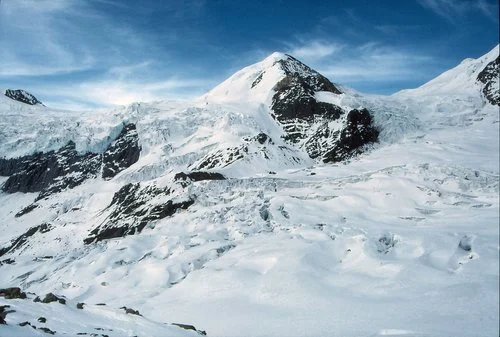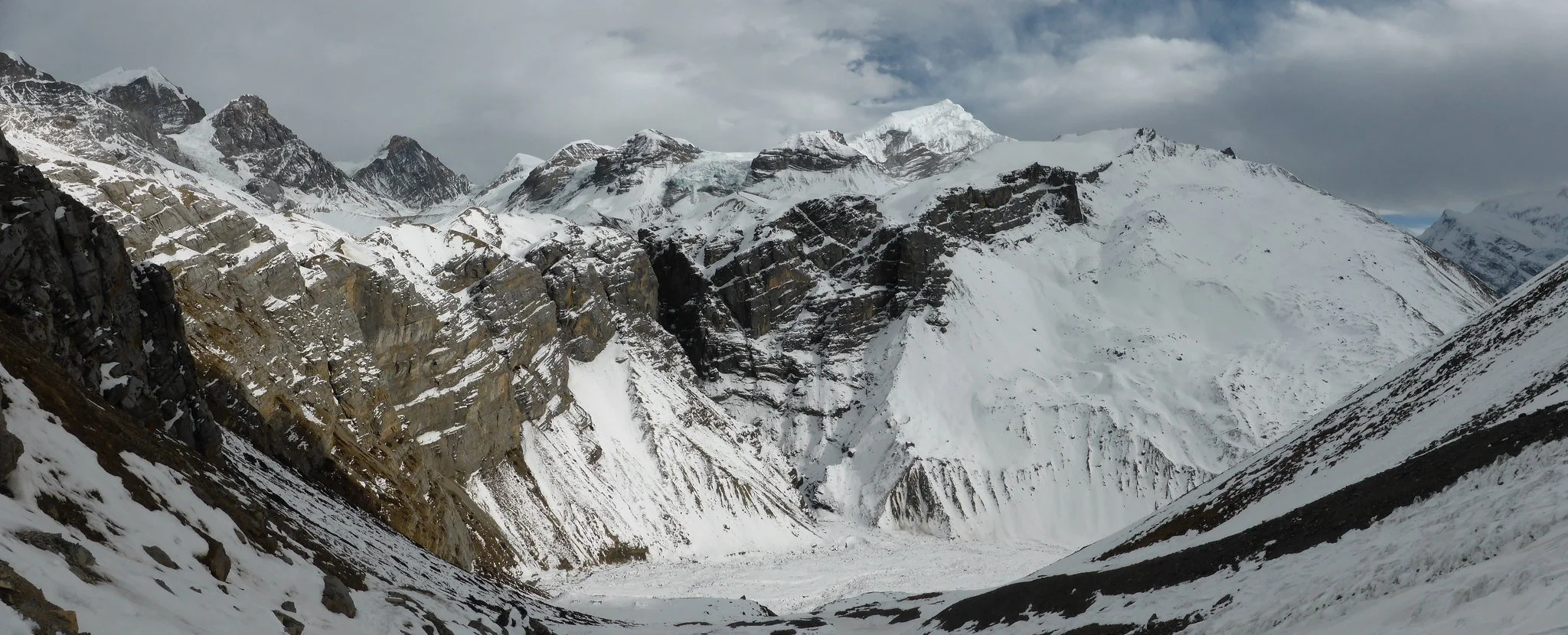12 Essential Things to Know About the Annapurna 5X Summit challenge, Nepal- NAMAS adventure
Chulu range in the Annapurna region.
1. Which Mountains Does the Annapurna 5x summit challenge Include?
The Annapurna 5x summit challenge includes FIVE impressive peaks that will challenge even experienced climbers and offer thrilling experiences for those looking to scale 6000+ meter mountains:
- Pisang Peak (6091M): Known for its moderate but still demanding technical climb, Pisang Peak provides an excellent introduction to alpine climbing with stunning views of the Annapurna massif.
- Chulu West (6419M): This peak is semi - technical climb, offering climbers an exciting and demanding ascent. It includes navigating crevasses and tackling a 90-degree vertical wall near the summit.
- Chulu East (9584M): Chulu East is the most technical climb of all and this peak is climb in alpine style with guided rope.
- Chulu Far East (6049M): A moderately technical climb, suitable for climbers looking to push their limits without extreme technical challenges.
- Tilicho Peak (6144M): The final summit and least technical climb in amongst the 5 6000ers in the itinerary
2. When is the Best Time to Climb the Annapurna 5xSummit challenge?
The best time to climb this expedition is during the Spring (March - May)and Autumn (September - November) seasons. These months offer the clearest skies and the most stable weather conditions, allowing for the safest and most enjoyable experience. While it’s possible to climb in winter, this season brings higher risks, including unpredictable weather conditions and closed tea houses. For an optimal experience, spring and autumn are ideal.
3. Is it Possible to Shorten the Annapurna 5xsummit Expedition?
Yes, it is possible to shorten the expedition by using helicopters for specific portions of the journey. After summiting the final peak, you can fly back to Kathmandu from either the base camp or a nearby village. Keep in mind that helicopter charter services can cost between $3500 and $4500 depending on the drop-off location and number of passengers. This service is available for those looking to expedite their journey after completing the climb.
4. How Much Does It Cost? What Does the Cost Include?
Our Annapurna 5x Summit challenge price (please see our website). This all-inclusive price ensures that you are well taken care of during every aspect of your journey. Here’s a breakdown of what’s included:
Certified guide leader (IFMGA or NMA)
1:2 Sherpa to climber ratio
Namas branded gear (down jacket, cap, buff)
All trekking and climbing permits
Internal transportation to and from the trekking trailhead
All meals during trekking and expedition days
Accommodation during the trek
Equipment for the climb (including tents, satellite phones, and oxygen cylinder)
30kg personal weight allowance (additional porter can be arranged for an extra fee)
Welcome or farewell dinners
5. Are Guides Necessary for the the annapurna 5xsummit challenge?
Yes, guides are mandatory for all peak climbing expedition in Nepal, not only for safety and legal reasons but also to ensure the highest chance of success. Guides with years of experience navigating the Annapurna region are invaluable for the technical challenges of climbing peaks like Chulu East/West, which requires climbing vertical walls and navigating ice-covered slopes. Additionally, the mandatory presence of a guide helps climbers overcome logistical hurdles and provide the support needed during the high-altitude trek. The guide's expertise ensures a smoother, more enjoyable expedition.
6. What is the Best Acclimatization Itinerary?
Acclimatization is crucial for high-altitude climbing, and our carefully designed itinerary ensures gradual ascent to help your body adjust. The following approach has been formulated based on years of experience and understanding of the challenges posed by high altitudes:
Pisang Base Camp: You will first acclimatize by spending time at Pisang Base Camp (4380m) and high camp (5400m) before summiting Pisang Peak. This slow and steady approach ensures your body adapts to the thinner air at higher elevations.
Chulu Far East: After Pisang, the expedition continues to Chulu Far East Base Camp (4600m) and then progresses to the high camp (5400m). The acclimatization days are key for success on the climb.
7. What Training Is Required for the Annapurna 5x Summit Expedition? Can You Suggest a Training Plan?
As the itinerary suggest (climbing 5x6000m peaks) this expedition is demanding journey, requiring participants to be in top physical and mental condition. While the climb is accessible to those with intermediate mountaineering skills, proper training is essential for success.
Here’s a recommended training plan:
- Endurance Training: Focus on aerobic exercises like long-distance running (15-20km), cycling, or hiking with a weighted pack (10-15kg).
- Strength and Stamina: Incorporate weight training and hill climbing to build leg and core strength.
- Technical Skills: If possible, take mountaineering classes to learn how to use climbing tools (ropes, crampons, ice axes) and navigate challenging terrain.
- Mental Preparation: High-altitude climbing requires mental resilience. Visualization exercises, meditation, and mindfulness can help manage stress on the mountain.
8. How Hard is the Annapurna 5Xsummit challenge?
The expedition challenge is moderately challenging climb, but the difficulty increases as you summit each peak. Chulu East and west is the most technically demanding with a rating of AD/3, requiring climbing on steep, icy terrain. Pisang and Chulu Far East are more manageable but still require solid endurance and technique. Each summit will demand long days of climbing, often lasting 8-10 hours of strenuous activity. The climb also takes place at altitudes over 6000 meters, which adds an additional physical challenge. Acclimatization, fitness, and mental fortitude are key to overcoming the difficulties posed by the mountain environment.
9. Clothing and Gear Requirements? Can I Rent Gear?
Proper gear is critical for success of this expedition. Here’s a general list of recommended clothing and equipment:
- Trekking and Mountaineering Boots: Sturdy, insulated boots for both trekking and climbing.
- Warm, Layered Clothing: Ensure proper layering for warmth (down jacket, fleece, thermals).
- Climbing Gear: Crampons, ice axe, helmet, harness, ropes, and a climbing rope.
- Sleeping Bag: Rated for temperatures as low as -20°C.
- Gloves and Goggles: Protect your hands and eyes from the cold and sun.
Namas Adventure offers high-quality gear rentals, ensuring you have the best equipment without needing to invest in everything yourself. We recommend using our gear, as it is meticulously maintained and tested for reliability in the harsh Himalayan environment.
10. What Types of Foods Are Available During this expedition challenge? Is Clean Water Available?
Meals are an essential part of the climbing experience. While on expedition, you can expect hearty meals designed to fuel your climb. On trekking days, food is prepared at the local tea houses, and during the high-altitude climb, our Sherpa chefs will prepare nutritious meals to keep you energized. Water is crucial at high altitudes, and we recommend drinking 4-6 liters per day to stay properly hydrated. Water is purified from natural sources or purchased from local tea houses, and we also provide hydration tablets for extra safety.
11. What Trip Insurance Will I Need for this expedition challenge? Do I Need Helicopter Evacuation Coverage?
Comprehensive travel insurance is a must for all high-altitude expeditions. Insurance should cover:
Emergency evacuation (including helicopter evacuation)
Medical coverage (for altitude sickness or injury)
Trip cancellation and interruption
Reparations
For helicopter evacuation, it is critical to ensure your policy covers this. In the event of an emergency, evacuation by helicopter will be arranged, with upfront costs reimbursed upon your return with the necessary documentation.
12. Which expedition Can I Aim for After the Annapurna 5x summit challenge?
Once you've completed this exciting expedition challenge, you might want to continue challenging yourself with even higher peaks. Here are a few recommendations for those looking to take their climbing skills to the next level:
Each of these peaks presents unique challenges, and completing the Annapurna 5xsummit challenge is a great stepping stone for tackling them.
Conclusion
The Annapurna 5X summit challenge Expedition offers an exciting, challenging, and rewarding experience for climbers of intermediate to advanced levels. This 30-day journey takes you through some of the most stunning landscapes in Nepal, from the Annapurna circuit to the summits of three magnificent peaks. With proper preparation, training, and guidance, this expedition will be one of the most memorable achievements of your mountaineering career. This expedition is a true test of both physical endurance and mental resilience — essential preparation for higher, more demanding climbs.
If you’re ready for the challenge, we would love to have you join us on this unforgettable adventure. For more information, feel free to contact us at bookings@namasadventure.com.
Live Your Story.
NAMAS Adventure


